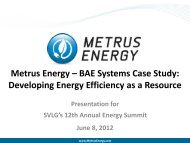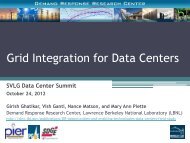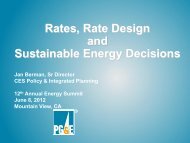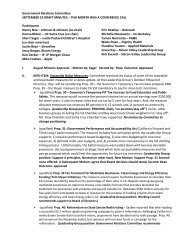2007 Silicon Valley Projections - Silicon Valley Leadership Group
2007 Silicon Valley Projections - Silicon Valley Leadership Group
2007 Silicon Valley Projections - Silicon Valley Leadership Group
Create successful ePaper yourself
Turn your PDF publications into a flip-book with our unique Google optimized e-Paper software.
Energy<br />
Price Volatility<br />
Comparing Gas Volitility<br />
to the Dow Jones<br />
• The natural gas price rally and<br />
subsequent price break in the last<br />
year would be equivalent of the<br />
Dow Jones going from 10,000 to<br />
25,000 and then back to 10,000.<br />
Over-Reliance on Natural Gas?<br />
One hurricane, then a second one exposed our weakness. Just<br />
like 6 years ago, the first rumblings of revolutionary change<br />
began in the natural gas market.<br />
Three headlines further clarified the emerging risk:<br />
• India declares a moratorium on new natural gas plants<br />
after 2012.<br />
• New natural gas pipeline to connect the gas-hungry<br />
eastern market with sources in the west.<br />
• Russia cuts off natural gas to customers in Europe.<br />
When hurricane Katrina mowed over the Gulf of Mexico,<br />
wrecking 15% of the nation’s capacity to deliver natural gas,<br />
prices soared 200% to an all time high of $15.62 (per thousand<br />
cubic feet).<br />
Now customers are paying attention. Risk management plans<br />
become required strategy. We were saved by a very mild winter,<br />
but experts predict $10-15 gas may become normal.<br />
The problem exposed by these events: “Half of our baseload is<br />
supplied by natural gas.”<br />
We are vulnerable and there is currently no workable substitute.<br />
New policies to control CO2, which will be signed by<br />
the Governor and the CPUC this year will render abundant<br />
and cheap conventional coal power not available. In addition,<br />
nothing has less legislative support than new dams for clean<br />
hydropower, and building a new nuclear plant is still officially<br />
illegal in the state.<br />
Can Wind and Solar Step In?<br />
Why can’t we just switch to renewable power like solar and<br />
wind? Why not indeed?<br />
Unfortunately, the physics of power production include limitations<br />
that are seldom discussed. Wind generated power’s<br />
secret is that the closer we get to the peak, the more it disappears.<br />
For July 24, 2006, our all-time record day, wind sources<br />
lost 80% of its capacity by the time we reached the peak in<br />
late afternoon, not even providing 2% of what we needed.<br />
This is typical. California use peaks from 3 to 6 pm, but wind<br />
typically peaks at 2 in the morning. Wind power must be<br />
backed up by baseload such as natural gas, nuclear and<br />
hydro-power. This fundamental weakness will remain until<br />
cost-effective energy storage technology catches up.<br />
What About Solar?<br />
Although less intermittent, solar power similarly suffers from<br />
a lack of coincidence with peak use, and is 2 to 5 times more<br />
costly per kilowatt generated. The good news is that breakthroughs<br />
in thin-film technology may change this.<br />
Further, neither solar nor wind can function to uphold the<br />
voltage of the grid to keep it stable from damaging surges and<br />
sags. Only baseload plants provide these “ancillary services” to<br />
smooth the bumps and dips created by these resources. This<br />
adds even more hidden costs.<br />
What, then, does our future hold? That depends.<br />
39












